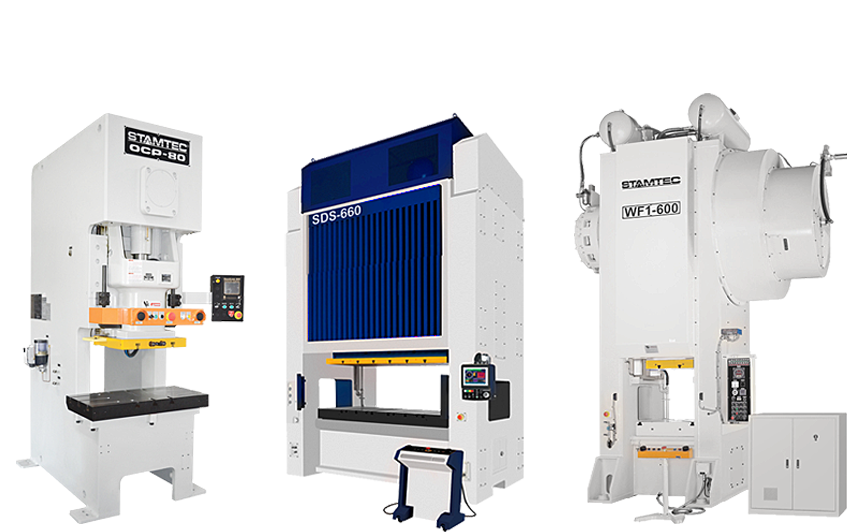
A Mechanical Press plays a vital role in various industries, driving the production of diverse parts through precise movements controlled by sophisticated press drives. Understanding the intricate dynamics of these drives is crucial for optimizing performance and achieving desired production outcomes.
Table Of Contents
At Stamtec, we recognize the multifaceted requirements of stamping operations, which is why we offer a comprehensive range of mechanical press machine drive options tailored to suit different applications and stamping needs.
One of the most important is the drive that controls the movement of the die and directly affects the type of part produced. Selecting the right drive depends on several application requirements, including:
Our drive train offerings include:
Mechanical Presses are the workhorses of the manufacturing world, producing millions of parts for a wide range of critical applications. Here’s a deep dive into the world of mechanical presses.
How does a mechanical press work?
Powered by an electric motor, a flywheel is engaged by a clutch and brake, driving a gear train that transmits the power to the crankshaft, which moves the press slide up and down. The motor then restores the energy to the flywheel, and the process begins again. The flywheel’s mass and speed determine the working energy of the press.
What are the advantages of using a mechanical press?
Mechanical presses are relatively inexpensive. Other advantages include fast production rates, very repeatable action with precision accuracy, and simple set-up and operation.
What applications are best suited to mechanical presses?
Mechanical presses are frequently used for flat to medium-depth drawn parts, like automotive, appliance and hardware components.
Stamtec is a leader in forging press technology. Our cold and warm-hot forging presses are recognized for their durability, repeatability and ability to reduce scrap. But many of our customers are unfamiliar with the process.
Here are a few facts to demystify the process.
What is a forging press?
A forging press forms parts from a billet – a length of round metal – rather than stamping pieces out of a sheet of metal.
What are the benefits of using a forging press?
Better part finish and a scrap reduction rate between 40% and 60% are two of the primary benefits. The reduced scrap rate means forging presses provide one of the most economical methods for manufacturing high precision parts. Stamtec forging presses also offer:
Your Stamtec press is humming along, working just as it should, when, suddenly, there’s a lube fault warning on the press controls, and production stops.
There’s no need to panic, but there are steps you can take to troubleshoot the issue and get your press back online.
Step 1: Very first thing to do is to check and make sure there’s enough grease in the grease cannister. If there’s not, add grease till it’s up to the proper level, making sure to use the external zerk fitting to do so. Do not try to take the plunger out to refill the cannister – this will only cause excessive air pockets and increase your problems. Cycle the pump and see if the lube fault is cleared, if not move to Step 2.
Servo Presses offer the best of both worlds – the slide velocity variability of hydraulic presses at the same or faster production speeds than mechanical presses.
The servo motors and controls that run servo presses account for the combined benefit of flexibility and speed.
But let’s step back and take a look at traditional mechanical presses to understand why servo presses are different. In mechanical presses, the flywheel mass and speed determine the amount of working energy available to form a part. This works well until a slower slide velocity is required to form the part effectively (since metal generally flows and forms better at slower speeds). To achieve the slower slide velocity, the flywheel needs to rotate more slowly, which diminishes the amount of working energy, preventing the press from properly forming the part.
Forging presses offer specific advantages due to the process by which they form parts.
Unlike stamping presses, which punch out shapes and leave scrap behind, a forging press takes in a length of round steel (called a “billet”) and forms it to the desired shape. Since it only takes in the material needed for the part, we can reduce scrap in most cases.
Another advantage of forging presses is a better finish quality.
We’re excited to host a special Servo Press Tooling Seminar specifically for metal stampers and tool and die shops September 18 at our Servo Press Technology Center and Die Try-Out Facility in Manchester, TN.
For more than 100 years, mechanical presses have been the mainstays of the metal-stamping world. They remain the most cost-effective solution for a high-production metal parts manufacturing system. Let’s take a closer look at these mechanical marvels.
From an operational standpoint, mechanical presses are straightforward: an electric motor supplies power to a flywheel that, when engaged by a clutch and brake, drives a gear train that transmits the power to the crankshaft, which moves the press slide up and down. The motor then restores the energy to the flywheel, and the process begins again. The working energy of the press depends on the flywheel’s mass and speed.
Press Advantages
These stamping machines offer a variety of advantages:
The two basic types of mechanical presses – gap frame and straight side – also offer their own benefits. Gap frame presses work well with smaller dies and provide easier access around the die. Straight side presses, offering greater rigidity and not as much deflection, provide higher accuracy and are usually more suitable for progressive die work.